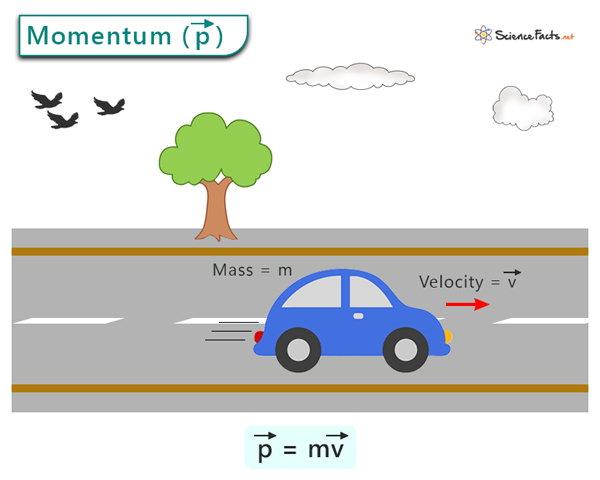Formula
Change in Momentum
Momentum, Force, and Impulse
Application
Example Problems
Momentum = mass x velocity p = mˑv Where p is the momentum m is the mass v is the velocity In vectorial notation The momentum along the positive axis direction is considered positive, while the momentum along the negative axis direction is considered negative. Unit & DimensionsThe SI unit for momentum is kgˑm/s. The cgs unit is gˑcm/s. Its dimensional formula is [M1 L1 T-1]. Momentum is a quantity involving the motion of an object. Objects with greater mass naturally have high momentum, but this will also depend on velocity. Suppose a car and a truck move on the highway with the same velocity. Both have momentum. The truck is heavier than the car, so it will have higher momentum. Δp = mvfinal – mvinitial => Δp = m(vfinal – vinitial) => Δp ꓿ mΔv Fnet = Δp/Δt => Δp = Fnet x Δt The term Fnet x Δt is known as an impulse. This equation shows that the impulse equals the average net external force multiplied by the time the force acts. It measures how quickly force changes in magnitude and direction. It is also equal to the change in momentum. The effect of a force on an object depends on how long it acts, as well as the strength of the force. Impulse is a valuable concept because it quantifies the effect of a force. A vast force acting for a short time can significantly affect an object’s momentum, such as the force of a racket hitting a tennis ball. A small force could cause the exact change in momentum, but it would have to act much longer. Solution Given m ꓿ 0.7 kg and m ꓿ 15 m/s The momentum is p ꓿ mv ꓿ 0.7 kg x 15 m/s ꓿ 10.5 kg·m/s Problem 2. A car of mass 980 kg travels at a speed of 45 m/s when it slams on the brakes and stops in 7 seconds. What is the momentum 3 seconds after it slams the brake? Solution Given m ꓿ 980 kg, v ꓿ 45 m/s, t = 7 s The acceleration (a) can be obtained from the following equation. v = u – at => 0 = 45 m/s – a x 7 s => a = 6.43 m/s2 Velocity after 3 seconds is v = u – at = 45 m/s – 6.43 m/s2 x 3 s = 25.7 m/s The momentum is given by p ꓿ mv => p ꓿ 980 kg x 25.7 m/s ꓿ 25,200 kg·m/s Problem 3. (a) Calculate the momentum of a 105 kg football player running at 9 m/s. (b) Compare the player’s momentum with a 0.390 kg football moving at 30 m/s. Solution The momentum is given by p ꓿ mv (a) The momentum of the football player is p ꓿ 105 kg x 9 m/s ꓿ 945 kg·m/s (b) The momentum of the football is p ꓿ 0.390 kg x 30 m/s ꓿ 11.7 kg·m/s Therefore, the player’s momentum is 80 times more than the ball. Although the ball has a greater velocity than the player, its momentum is low because of its low mass. When the player catches the ball, there will not be much impact on his momentum. Problem 4. 2. A car has 18,000 units of momentum. What will be its new momentum if a. its velocity is doubled? b. its mass is doubled (by adding more passengers)? c. both its velocity and mass doubled? Solution Given p ꓿ 18,000 units The momentum is given by p ꓿ mv a. If the mass is doubled, the new momentum is pnew ꓿ 2m x v ꓿ 2 x 18,000 ꓿ 36,000 units b. If the velocity is doubled, the new momentum is pnew ꓿ m x 2v ꓿ 2 x mv ꓿ 2 x 18,000 ꓿ 36,000 units Therefore, the momentum doubled when either the mass or the velocity doubled. c. If both the mass and the velocity are doubled, the new momentum is pnew ꓿ 2m x 2v ꓿ 4 x mv ꓿ 4 x 18,000 ꓿ 72,000 units Therefore, the momentum quadrupled when both the momentum and velocity doubled.
